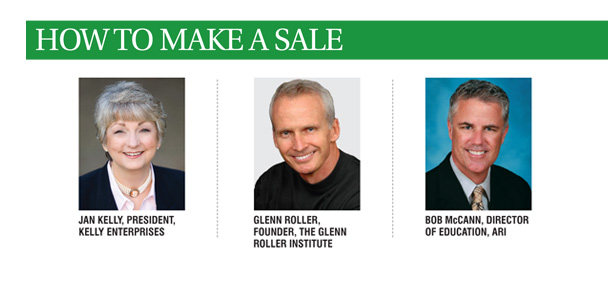How to make a sale: Ask questions, listen, follow-up

Three marine industry sales experts share ways to make the most of each customer who walks through your front door.
After dozens of social networking posts, hundreds of planning hours and thousands of marketing dollars, a customer walks into a showroom.
Now what?
Each customer who enters your showroom represents the culmination of a lot of money and effort, so it’s important to take every opportunity to convert them into a sale. Boating Industry recently spoke to three marine sales experts and asked for tips on how to do just that.
The First Two Minutes
When a customer walks in, salespeople have a very limited window to make their case. The first two minutes can make or break any chance you have to sell them a boat, according to Jan Kelly, president of Kelly Enterprises and a longtime marine industry sales trainer.
One common problem with that initial interaction? Too often, she says, salespeople are broadcasting rather than receiving. They use those precious minutes to inundate the customer with information rather than listen to their concerns.
“If you listen to salespeople, most of the time they meet [customers], they welcome them, and then they want to tell the customer everything they wanted to know about the boating industry in two minutes or less,” Kelly says. “They want to show how knowledgeable they are. They’ve learned all this product knowledge and somebody’s going to listen to it.”

In Kelly’s experience, in those first two minutes, the salesperson needs to ask questions, not make statements or simply take customers on a parade of inventory. By listening, asking pertinent questions and getting customers involved in the sales process, salespeople can both impress the customer and be better prepared to meet their needs.
“I tend to ask dealers, ‘Can your sales representative go two minutes without making a statement?’” Kelly says. “Can they ask open-ended questions and really listen?”
Getting out of broadcast mode
When Kelly goes into dealerships for training, before explaining the two-minute rule, she gives a stopwatch to one person, a yellow penalty flag to another and has a third act as recorder. Then each salesperson practices meeting and greeting a customer.
The longest anyone has gone without making a statement was a minute and a half. The shortest was 15 seconds.
 Kelly then explains the rule, and together she and the staff make a list of things they need to find out about the customer. Typical questions include: How many people do you go boating with? How often are you on the water? Do you like to fish? Do you have a boat now? What do you like about it and what would you change?
Kelly then explains the rule, and together she and the staff make a list of things they need to find out about the customer. Typical questions include: How many people do you go boating with? How often are you on the water? Do you like to fish? Do you have a boat now? What do you like about it and what would you change?
Kelly says that once salespeople stop broadcasting, their product selection is better, their presentation and demonstration of the unit is better, the write-up is easier, the close is easier, they end up making more money and their relationship with the customer is better.
By asking questions, Kelly says they can demonstrate that they care, making the customer more willing to provide information. And ideally, once the two minutes have elapsed, salespeople are ready to guide customers into a unit that they can afford.
Not only that, Kelly says salespeople who listen and build a relationship with a consumer are more willing to stay in contact with that consumer. That aids customer retention — something that is critical as the number of customers shopping for a boat dwindles.
“They may not be able to buy today, but they’re going to buy some day, and you want them to buy from you,” Kelly says. “And they’re going to come back to the person who listened to them. Who made them feel important. Who answered their questions. Who gave them information that was pertinent to their needs, wants, hope and desires.”
Listening techniques
To ask appropriate questions, salespeople need to learn how to listen. However, according to sales trainer Glenn Roller of the Glenn Roller Institute, typical salespeople have so much running through their heads while speaking to a customer they miss two-thirds of what the person is saying.
He recommends a simple way for salespeople to stay more present. Any time the customer shares something pertinent to the sale, he suggests taking their words and paraphrasing them back.
Examples of helpful phrases include: “It sounds like what you’re saying is …”; “It seems like …”; “So if I understand you correctly …”; or “I believe what you’re asking for …”

“This is a technique they can practice live with a customer any time,” he says. “It won’t cost them the sale practicing, and more than likely it will help them make the sale.”
The secret is that, for salespeople to feed back what they heard, they have to stop checking out in their heads and listen.
Roller says customers notice when salespeople aren’t focused on what they’re saying, but perhaps more importantly, they really recognize it when they are.
“It’s two steps forward rather than the one step back,” Roller says. “So the gap between the salesperson who doesn’t listen and the one who does is huge.”
Practicing
To practice this technique, Roller suggests a method called “real-play.” This is a version of role-play where the person pretending to be the customer takes a moment to select something in the dealership that they’d like to own and then, as much as possible, tries to be themselves during the practice encounter.
Given that most salespeople are not also accomplished actors, he says in traditional role-play, too often a person’s body language and verbal cues don’t line up.
“The problem with role-play is it means I’m going to pretend to be something I’m not,” Roller says. “It can turn out to be stump your buddy.”
Alternatively, someone in the dealership can share a true 30-second story and then ask salespeople to feed it back. Roller suggests having the person who told the story rate salespeople from one to 10 on how well the feedback captured the essence of what they said.
“It’s incredible how few people can do it,” Roller says. “They are checking out before the end of the story — and it’s 30 seconds.”
Follow-up
No matter how good salespeople become at asking questions and listening, not everyone will buy on their first visit to the dealership. That makes proper follow-up critical.
Bob McCann, director of education at ARI, says the marine industry is making strides in lead management, with people being contacted more often, more quickly and with better quality responses. However, after dealers have gotten customers into the showroom, he says there’s an opportunity for more structured follow-up.
“The area I think dealers could do a lot better in is just leveraging the traffic they’ve already had in their dealership,” he says. “Instead of looking for new leads, they need to be cultivating those seeds they planted already from the people who walked in their front door.”
When McCann talks about structure, he isn’t suggesting that every aspect of the process has to be strictly scheduled. Instead, he advocates for mandatory follow-up on a flexible timeline.

“I don’t believe that every customer who comes into your dealership is on the same schedule,” McCann says. “Some are going to buy tomorrow, some are going to buy next week, next month, next year. So you have to select touch points that aren’t going to be annoying and turn the customer off.”
One of the first touch points should be a follow-up email to thank them for coming in, link them to the unit they were looking at and set the stage for a phone call follow-up the next day. During that phone call, the conversation should again begin by thanking the customer for coming in and offering to answer any questions that have come up since they visited the showroom. Then the phone call should transition to getting the customer back in the dealership.
At that point, if they don’t decide to come in, you can make the decision on when to follow-up again. That could be later that afternoon or it could be the next month.
The importance of taking notes
Ideally, when you call the customer back, there should be a purpose to the phone call. Subsequent conversations should start off where the previous one finished, McCann says. If you took good notes on your last phone call, you can start there.
For the business overall, good notes are equally important. Often, a customer will show up when their salesperson isn’t around, so it’s important to have a central database that allows another salesperson or manager to jump in without making the customer start from scratch. Over the longer term, if you plan on keeping the customer for years, you want them to feel comfortable returning to the dealership even if the salesperson they worked with has left.
Post-sale follow-up
Your most qualified leads are the ones who have bought from you already, which makes post-sale follow-up just as important as anything that happens pre-sale. When someone buys a boat, it should be the first step of the next sale.
“It’s amazing how fast a year goes by,” McCann says. “It’s amazing how fast a couple years go by, and that’s when people want to change boats.”
If a customer had a good experience with the dealership, they will naturally be inclined to come back. But if they never hear from the dealer or salesperson again post-sale, they are less likely to be loyal and may venture out and look at other people’s products. There should be a system in place to ensure that previous customers are regularly contacted as well.
“You know they have good credit. You know they have desire. You know they have the water gene. They like your product already,” McCann says. “Who else would you want to cultivate?”





Mike, Excellent artilce. Especially good advice in (just) listening for the first two minutes. (as most sales folks want to talk). Also, I like the fact that you are emphasizing taking notes. That is a great technique to engage potential clients – as well as ensure the sales person is capturing key client interests.
You sales team can also find some valuable sales techniques at http://www.pinnacleselling.com.
Regards
Joe.
I sold Sea Ray boats for many years and had a very rewarding career. I read everything I could prior to that regarding selling and communicating, and learned how to solve the customer’s problems mostly by listening. I would like to say that I learned so very much from Glenn Roller while ne was Sea Ray Corporate sales trainer. I really do miss the boat business.
Best regards
Bob Ciafre